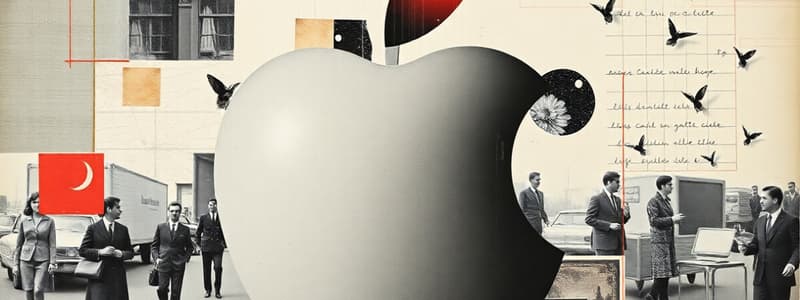Podcast
Questions and Answers
In the context of organizational culture, what is the key difference between 'espoused values' and 'actual culture'?
In the context of organizational culture, what is the key difference between 'espoused values' and 'actual culture'?
- Espoused values are those written in the company handbook, and actual culture is observed during external audits of the organization.
- Espoused values are the results of employee surveys of company values, while actual culture is determined by management assessment.
- Espoused values are the values that employees personally believe in, while actual culture is the values the organization promotes.
- Espoused values are what the leadership says the company believes in, while actual culture is what employees experience daily. (correct)
According to the discussion, which of the following best describes the role of 'basic assumptions' in shaping organizational culture, as described by Schein?
According to the discussion, which of the following best describes the role of 'basic assumptions' in shaping organizational culture, as described by Schein?
- Basic assumptions are values that are openly stated and promoted by leadership.
- Basic assumptions are deeply held, often unconscious beliefs that guide behavior. (correct)
- Basic assumptions are visible organizational artifacts like slogans and office spaces.
- Basic assumptions are the rules, roles, and procedures that govern daily operations.
Based on the case discussion, what is the most significant risk when an organization's 'espoused values' do not align with its 'actual culture'?
Based on the case discussion, what is the most significant risk when an organization's 'espoused values' do not align with its 'actual culture'?
- A stronger, more unified sense of purpose among employees.
- Increased innovation due to creative tension between values and practices.
- Decreased employee motivation, engagement, and satisfaction. (correct)
- Improved external reputation as the company is seen as aspirational.
According to the discussion, how does the cultural concept of 'challenging authority' relate to Schein's model of organizational culture?
According to the discussion, how does the cultural concept of 'challenging authority' relate to Schein's model of organizational culture?
Using Handy's cultural models, which type of culture is most likely to be characterized by bureaucracy, rules, and procedures?
Using Handy's cultural models, which type of culture is most likely to be characterized by bureaucracy, rules, and procedures?
According to the scenario, what is a potential negative consequence of a 'Power Culture' within an organization?
According to the scenario, what is a potential negative consequence of a 'Power Culture' within an organization?
Based on the discussion of organizational culture, how might visible aspects like slogans and office spaces relate to Schein's model?
Based on the discussion of organizational culture, how might visible aspects like slogans and office spaces relate to Schein's model?
How does Herzberg's Two-Factor Theory relate to the discussion of organizational culture and motivation?
How does Herzberg's Two-Factor Theory relate to the discussion of organizational culture and motivation?
How can Adams' Equity Theory influence employee motivation in the context of organizational culture?
How can Adams' Equity Theory influence employee motivation in the context of organizational culture?
How does Vroom's Expectancy Theory explain the link between organizational culture and employee motivation?
How does Vroom's Expectancy Theory explain the link between organizational culture and employee motivation?
What is the central idea behind the discussion of motivation and cultural mismatch?
What is the central idea behind the discussion of motivation and cultural mismatch?
What would be the best action for a company to take to align its espoused values to the reality of its organizational culture?
What would be the best action for a company to take to align its espoused values to the reality of its organizational culture?
An employee expresses a need to feel appreciated for their work, reflecting both motivators and hygiene factors. Which theory would directly address these aspects?
An employee expresses a need to feel appreciated for their work, reflecting both motivators and hygiene factors. Which theory would directly address these aspects?
In a cultural context, which example illustrates the application of Adams' Equity Theory?
In a cultural context, which example illustrates the application of Adams' Equity Theory?
If an organization implements a policy that promotes work-life balance to increase employee satisfaction, is this referencing a hygiene or motivating factor?
If an organization implements a policy that promotes work-life balance to increase employee satisfaction, is this referencing a hygiene or motivating factor?
Which of the following scenarios best demonstrates Vroom's Expectancy Theory in an organizational setting?
Which of the following scenarios best demonstrates Vroom's Expectancy Theory in an organizational setting?
How might a 'Task Culture,' according to Handy's model, approach problem-solving?
How might a 'Task Culture,' according to Handy's model, approach problem-solving?
Which of Schein's levels of culture are most likely to be influenced by an organization's mission statement?
Which of Schein's levels of culture are most likely to be influenced by an organization's mission statement?
What is the initial step an organization should take to improve employee motivation, after an audit reveals a significant cultural mismatch?
What is the initial step an organization should take to improve employee motivation, after an audit reveals a significant cultural mismatch?
What is the primary focus of Handy's 'Role Culture?'
What is the primary focus of Handy's 'Role Culture?'
Which type of culture, according to Handy, is best suited for quickly adapting to changing market conditions and fostering innovation?
Which type of culture, according to Handy, is best suited for quickly adapting to changing market conditions and fostering innovation?
Under what circumstances might a Power Culture be detrimental to an organization's long-term success?
Under what circumstances might a Power Culture be detrimental to an organization's long-term success?
Which statement accurately represents the relationship between organizational culture and motivation?
Which statement accurately represents the relationship between organizational culture and motivation?
Which of the following best captures the essence of the course's teaching on organizational culture?
Which of the following best captures the essence of the course's teaching on organizational culture?
Flashcards
Organizational Culture
Organizational Culture
The shared values, norms, and practices that guide behavior in an organization.
Espoused Values
Espoused Values
The values and beliefs an organization says it supports.
Basic Assumptions
Basic Assumptions
Deeply held, often unconscious beliefs that guide behavior.
Task Culture
Task Culture
Signup and view all the flashcards
Power Culture
Power Culture
Signup and view all the flashcards
Role Culture
Role Culture
Signup and view all the flashcards
Motivation
Motivation
Signup and view all the flashcards
Expectancy Theory (Vroom)
Expectancy Theory (Vroom)
Signup and view all the flashcards
Equity Theory
Equity Theory
Signup and view all the flashcards
Two-Factor Theory
Two-Factor Theory
Signup and view all the flashcards
Cultural Mismatch
Cultural Mismatch
Signup and view all the flashcards
Study Notes
Apple's Culture Discussion
- Apple's case study portrays it as a highly admired company
- Tim Cook emphasizes Apple's innovative culture, promoting creative thinking from everyone
- Apple's culture resembles a Task Culture, flexible and focused on teamwork
- Employee reviews reveal that projects lacking Steve Jobs' involvement face delays and bureaucracy
- Apple's culture is not quite the buzzing innovation lab it promotes
- The culture may be stressful, top-down, and discourages questioning
- Apple can also represent a Power Culture
- Handy's Role Culture applies, especially in bureaucratic settings
- A contradiction exists between espoused values (leadership's emphasis on creativity and freedom) and the actual day-to-day culture
- Schein's model is applicable, highlighting the difference between visible artifacts and hidden assumptions
- Company culture is revealed in what people are comfortable or afraid to say
Reflection on Cultural Mismatch
- Discrepancies between the culture promoted by senior managers and the reality experienced by staff affects motivation
Motivation and Cultural Mismatch
-
Mismatches affect how people feel at work
-
Being ignored despite being told your ideas matter is demotivating
-
Vroom's Expectancy Theory suggests that if employees don't believe their effort leads to valued outcomes, motivation decreases
-
Herzberg's Two-Factor Theory states that stress, poor leadership, and lack of recognition can lead to hygiene related issues and decrease motivation
-
Culture shapes whether people want to behave in certain ways
-
Adams' Equity Theory shows that perceived unfairness, can lead to disengagement
-
Organisational culture is what the company says versus what employees experience
-
Cultural mismatch is the gap between espoused values and actual practices
-
Motivation impact results in decreased effort, engagement, and satisfaction
Class Activity Suggestion
- In groups of 3-4 to analyse Apple's culture using Schein's three levels
- Analyse cultural features that increase or reduce employee motivation, using motivation theories
Glossary of Key Terms
- Organisational culture refers to shared values, norms, and practices that guide behaviour in an organisation
- Espoused Values are the values and beliefs an organisation says it supports
- Basic assumptions are deeply held, often unconscious beliefs that guide behaviour
- Task culture is a flexible, team-based culture focused on solving problems
- Power culture is a centralized culture where influence is concentrated at the top
- Role culture is a bureaucracy-driven culture based on rules, roles, and procedures
- Motivation is the internal drive that influences people to act or behave in certain ways
- Expectancy Theory is a motivation theory that suggests people act based on expected outcomes
- Equity Theory is a theory that motivation is influenced by fairness and balance in input vs. reward
- Two-Factor Theory is Herzberg's theory that job satisfaction is influenced by hygiene and motivating factors
Summary Takeaways
- Organisational culture includes what people feel and experience
- Frameworks like Handy and Schein helps to understand the visible and hidden sides of culture
- Motivation suffers when culture doesn't support employee needs or values, even in successful companies like Apple
- Theories of motivation explain how and why culture impacts behavior and performance
Studying That Suits You
Use AI to generate personalized quizzes and flashcards to suit your learning preferences.




